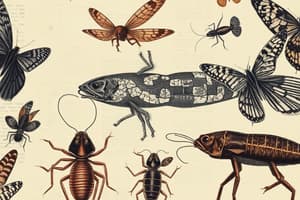Podcast
Questions and Answers
The majority of animal species are invertebrates.
The majority of animal species are invertebrates.
True (A)
Which of the following is NOT a type of skeletal structure found in invertebrates?
Which of the following is NOT a type of skeletal structure found in invertebrates?
- Exoskeleton
- Endoskeleton (correct)
- Hydrostatic skeleton
- None of the above
What is the name of the study of the animal kingdom?
What is the name of the study of the animal kingdom?
Zoology
Animals that are attached to a surface and do not move are referred to as ______.
Animals that are attached to a surface and do not move are referred to as ______.
Match the following terms with their corresponding definitions:
Match the following terms with their corresponding definitions:
Where does the chemical digestion of food occur in an earthworm?
Where does the chemical digestion of food occur in an earthworm?
Earthworms have an open circulatory system.
Earthworms have an open circulatory system.
What is the name of the solid waste produced by earthworms?
What is the name of the solid waste produced by earthworms?
The earthworm's thin ______ is responsible for gas exchange.
The earthworm's thin ______ is responsible for gas exchange.
Match the following structures with their functions in an earthworm:
Match the following structures with their functions in an earthworm:
Which of the following is NOT a characteristic of the phylum Mollusca?
Which of the following is NOT a characteristic of the phylum Mollusca?
All mollusks have shells.
All mollusks have shells.
The tongue-like structure in mollusks that is made of chitin is called a ______.
The tongue-like structure in mollusks that is made of chitin is called a ______.
What is the name of the specialized cells in squid that contain pigments and are used for camouflage?
What is the name of the specialized cells in squid that contain pigments and are used for camouflage?
Which of the following is a characteristic of echinoderms?
Which of the following is a characteristic of echinoderms?
Which of the following are characteristics of a flatworm?
Which of the following are characteristics of a flatworm?
Seahorses are born as miniature versions of their adult form.
Seahorses are born as miniature versions of their adult form.
What is the primary function of the collar cells in a sponge?
What is the primary function of the collar cells in a sponge?
The type of symmetry exhibited by jellyfish and sea urchins is called ______ symmetry.
The type of symmetry exhibited by jellyfish and sea urchins is called ______ symmetry.
Match the following terms related to annelid worms with their descriptions:
Match the following terms related to annelid worms with their descriptions:
Which of these organisms exhibits bilateral symmetry?
Which of these organisms exhibits bilateral symmetry?
What is the difference between budding and regeneration in terms of asexual reproduction?
What is the difference between budding and regeneration in terms of asexual reproduction?
The stinging cells found in cnidarians are called ______.
The stinging cells found in cnidarians are called ______.
Tapeworms have a complete digestive tract.
Tapeworms have a complete digestive tract.
Which of the following organisms is an example of a free-living flatworm?
Which of the following organisms is an example of a free-living flatworm?
Describe the role of the mesoderm in embryonic development.
Describe the role of the mesoderm in embryonic development.
In earthworms, the ______ helps identify the anterior end of the worm.
In earthworms, the ______ helps identify the anterior end of the worm.
All worms are segmented.
All worms are segmented.
Which of the following is NOT a characteristic of the Phylum Porifera?
Which of the following is NOT a characteristic of the Phylum Porifera?
How does the presence of a cuticle in roundworms contribute to their survival?
How does the presence of a cuticle in roundworms contribute to their survival?
Flashcards
Invertebrates
Invertebrates
Animals without backbones, making up 95% of all animal species.
Ectothermic
Ectothermic
Animals that rely on external environment for body temperature regulation.
Oviparous
Oviparous
Animals that develop in an egg outside the mother's body.
Viviparous
Viviparous
Signup and view all the flashcards
Hydrostatic skeleton
Hydrostatic skeleton
Signup and view all the flashcards
Gizzard function
Gizzard function
Signup and view all the flashcards
Intestinal digestion
Intestinal digestion
Signup and view all the flashcards
Casts
Casts
Signup and view all the flashcards
Closed circulatory system
Closed circulatory system
Signup and view all the flashcards
Dorsal blood vessel
Dorsal blood vessel
Signup and view all the flashcards
Ventral blood vessel
Ventral blood vessel
Signup and view all the flashcards
Nephridia
Nephridia
Signup and view all the flashcards
Respiration in earthworms
Respiration in earthworms
Signup and view all the flashcards
Radula
Radula
Signup and view all the flashcards
Water vascular system
Water vascular system
Signup and view all the flashcards
Larval Stage
Larval Stage
Signup and view all the flashcards
Phylum Porifera
Phylum Porifera
Signup and view all the flashcards
Cnidocyte
Cnidocyte
Signup and view all the flashcards
Radial Symmetry
Radial Symmetry
Signup and view all the flashcards
Bilateral Symmetry
Bilateral Symmetry
Signup and view all the flashcards
Phylum Annelida
Phylum Annelida
Signup and view all the flashcards
Regeneration
Regeneration
Signup and view all the flashcards
Amoebocytes
Amoebocytes
Signup and view all the flashcards
Gemmules
Gemmules
Signup and view all the flashcards
Scolex
Scolex
Signup and view all the flashcards
Setae
Setae
Signup and view all the flashcards
Clitellum
Clitellum
Signup and view all the flashcards
Incomplete Digestive Tract
Incomplete Digestive Tract
Signup and view all the flashcards
Phylum Nematoda
Phylum Nematoda
Signup and view all the flashcards
Study Notes
Invertebrates
- Invertebrates comprise 95% of all animal species.
- They lack backbones.
- They are classified into various phyla, including Porifera, Cnidaria, Platyhelminthes, Nematoda, and Annelida.
- Ectothermic animals regulate their body temperature through external factors. Endothermic animals have internal mechanisms for regulating body temperature.
Invertebrate Life Processes
- Movement: Some invertebrates are sessile (attached and immobile) while others exhibit various forms of locomotion.
- Support: They may have exoskeletons, endoskeletons, or hydrostatic skeletons.
- Body Covering: Invertebrates can have varied body coverings, with structures and coloration playing a role in protection and identification.
- Nutrition: Involves ingestion, digestion, egestion, and excretion—removal of waste products through diffusion.
- Respiration: All invertebrates are aerobic, meaning their respiration requires oxygen.
- Circulation: Methods of transporting materials throughout the body vary.
- Response: Invertebrates exhibit stimuli-response behaviors.
- Reproduction: Primarily, sexual reproduction occurs through fertilization (internal or external). Several have also developed asexual methods.
- Development: Invertebrates experience diverse types of development, including oviparous (egg-laying), viviparous (live birth), and ovoviviparous (egg development within the parent).
- Larval Stages: Many invertebrates have larval stages that differ significantly from adult forms.
Phylum Porifera (Sponges)
- Sponges are filter feeders.
- They have incurrent pores (ostia) and an excurrent pore (osculum).
- Collar cells (choanocytes) with flagella circulate water through the sponge, capturing food particles.
- Sponges have two cell layers and support structures called spicules composed of calcium carbonate, silica, or spongin.
- Reproduction can be asexual through budding or regeneration, or sexual through the release of sperm and eggs.
Phylum Cnidaria (Hydra, Jellyfish, Coral)
- Cnidarians have specialized cells called cnidocytes that contain nematocysts (stinging structures).
- Polyp form is typically sessile, while medusa form is motile.
- They possess a hydrostatic skeleton.
- This phylum displays radial symmetry.
- The hydra has two cell layers, ectoderm, and gastrodermis, separated by mesoglea.
- The gastrovascular cavity plays a role in digestion (both intracellular and extracellular).
- Some cnidarians reproduce asexually through budding or regeneration, and sexually via separate sexes.
Phylum Platyhelminthes (Flatworms)
- Free-living flatworms, like planarians, exhibit bilateral symmetry and cephalization.
- Planarians move using cilia and have a simple nervous system.
- Other members, like parasitic tapeworms, lack external cilia and have suckers and/or hooks for attachment.
- Tapeworms have a scolex (head) and proglottids (segments).
Phylum Nematoda (Roundworms)
- Roundworms are unsegmented with a complete digestive tract.
- Ascaris is an example of a human intestinal parasite.
Phylum Annelida (Segmented Worms)
- Segmented worms, like earthworms, exhibit bilateral symmetry.
- They have setae that aid in locomotion.
- They possess longitudinal and circular muscles for movement.
- Earthworms have a closed circulatory system with a dorsal blood vessel, ventral blood vessel, and aortic arches (helping to regulate blood pressure).
- They breathe through their moist epidermis.
- They have nephridia for excretion.
- Earthworms are hermaphroditic.
Phylum Mollusca (Clams, Snails, Octopuses)
- Mollusks exhibit bilateral symmetry and cephalization.
- They often have a shell secreted by a mantle.
- They typically possess a radula (tongue-like structure).
- Siphon for water intake/exit.
- Some have chromatophores for camouflage.
Phylum Echinodermata (Starfish, Sea Urchins)
- Echinoderms are exclusively marine invertebrates.
- They exhibit radial symmetry, often in multiples of five.
- They have a water vascular system with tube feet used for locomotion and feeding.
- They demonstrate significant regeneration capability.
Studying That Suits You
Use AI to generate personalized quizzes and flashcards to suit your learning preferences.




